Brihadaranyaka Upanishad Bhashya Vartika
190 111 753MB
English Pages [3858]
3 (11)_2R
3 (12)_1L
3 (12)_2R
3 (13)_1L
3 (13)_2R
3 (14)_1L
3 (14)_2R
3 (15)_1L
3 (15)_2R
3 (16)_1L
3 (16)_2R
3 (17)_1L
3 (17)_2R
4 (00)_1L
4 (00)_2R
4 (01)_1L
4 (01)_2R
4 (02)_1L
4 (02)_2R
4 (03)_1L
4 (03)_2R
4 (04)_1L
4 (04)_2R
4 (05)_1L
4 (05)_2R
4 (06)_1L
4 (06)_2R
4 (07)_1L
4 (07)_2R
4 (08)_1L
4 (08)_2R
4 (09)_1L
4 (09)_2R
4 (10)_1L
4 (10)_2R
4 (11)_1L
4 (11)_2R
4 (12)_1L
4 (12)_2R
4 (13)_1L
4 (13)_2R
4 (14)_1L
4 (14)_2R
4 (15)_1L
4 (15)_2R
4 (16)_1L
4 (16)_2R
4 (17)_1L
4 (17)_2R
4 (18)_1L
4 (18)_2R
4 (19)_1L
4 (19)_2R
4 (20)_1L
4 (20)_2R
4 (21)_1L
4 (21)_2R
4 (22)_1L
4 (22)_2R
4 (23)_1L
4 (23)_2R
4 (24)_1L
4 (24)_2R
4 (25)_1L
4 (25)_2R
4 (26)_1L
4 (26)_2R
4 (27)_1L
4 (27)_2R
4 (28)_1L
4 (28)_2R
4 (29)_1L
4 (29)_2R
4 (30)_1L
4 (30)_2R
4 (31)_1L
4 (31)_2R
4 (32)_1L
4 (32)_2R
4 (33)_1L
4 (33)_2R
4 (34)_1L
4 (34)_2R
4 (35)_1L
4 (35)_2R
4 (36)_1L
4 (36)_2R
4 (37)_1L
4 (37)_2R
4 (38)_1L
4 (38)_2R
4 (39)_1L
4 (39)_2R
4 (40)_1L
4 (40)_2R
4 (41)_1L
4 (41)_2R
4 (42)_1L
4 (42)_2R
4 (43)_1L
4 (43)_2R
4 (44)_1L
4 (44)_2R
4 (45)_1L
4 (45)_2R
4 (46)_1L
4 (46)_2R
4 (47)_1L
4 (47)_2R
4 (48)_1L
4 (48)_2R
4 (49)_1L
4 (49)_2R
4 (50)_1L
4 (50)_2R
4 (51)_1L
4 (51)_2R
4 (52)_1L
4 (52)_2R
4 (53)_1L
4 (53)_2R
4 (54)_1L
4 (54)_2R
4 (55)_1L
4 (55)_2R
4 (56)_1L
4 (56)_2R
4 (57)_1L
4 (57)_2R
4 (58)_1L
4 (58)_2R
4 (59)_1L
4 (59)_2R
4 (60)_1L
4 (60)_2R
4 (61)_1L
4 (61)_2R
4 (62)_1L
4 (62)_2R
5 (00)_1L
5 (00)_2R
5 (01)_1L
5 (01)_2R
5 (02)_1L
5 (02)_2R
5 (03)_1L
5 (03)_2R
5 (04)_1L
5 (04)_2R
5 (05)_1L
5 (05)_2R
5 (06)_1L
5 (06)_2R
5 (07)_1L
5 (07)_2R
5 (08)_1L
5 (08)_2R
5 (09)_1L
5 (09)_2R
5 (10)_1L
5 (10)_2R
5 (11)_1L
5 (11)_2R
5 (12)_1L
5 (12)_2R
5 (13)_1L
5 (13)_2R
5 (14)_1L
5 (14)_2R
5 (15)_1L
5 (15)_2R
5 (16)_1L
5 (16)_2R
5 (17)_1L
5 (17)_2R
5 (18)_1L
5 (18)_2R
5 (19)_1L
5 (19)_2R
5 (20)_1L
5 (20)_2R
Recommend Papers
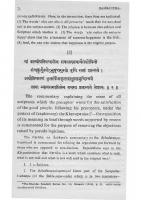
- Author / Uploaded
- Suresvara
File loading please wait...
Citation preview
)
x S AMB ANDH A- V ARTIK A
fRR
M
^
|
^3^
With devotion do imperishable, unborn,
bow
I
all-pervasive
?
||
who is and partless, who one
that
to
||
stands far above the operations of all speech and thought,
who makes
the universe
happy and
being endowed with parts veiled
whom
they regard as
—they whose view of the Self
by the potent delusion which
is
is
brought about by
the expansive world of duality, generated by the power
of nescience resident in themselves. This is
eternal
is
an invocation addressed to the supreme Reality which
and without
parts,
and mind. That Reality the source of
no
divisions in
avidya
(i
all
which
is
of the nature of unexcellable
happiness.
it.
and which transcends the reach of speech
one without a second.
It is
The apparent
differentiations are
veils the real self
and
of the illusory world.
veils it,
is
is
There are
due to nescience
self.
Somehow
it
and weaves the variegated texture
Being blinded by
imagine that the supreme
and
and projects the non-real world.
Nescience too has no locus apart from the non-dual resides in the self
bliss,
this illusion, the
a whole-of-parts, and that
it
ignorant
really creates
the world.
Four preliminary matters anubandha-catustaya) are to be (
II
II
was studied
it
in
both in extent and sense,
it
called Brhaddranyaka, Here, the expressions aranyaka and brhat are explained.
the Upanisad was taught and studied in the forest-regions,
aranyaka
And,
as
it
is
great both in length
and
in
it is
As
called
meaning,
it is
Brhat + aranyaka 4- upanisad = Brhadaranyakopani sad
brhat.
[
10 ]
gi%*TR wsh**.
?
h
11
Thus under the pretext of explaining the etymolomeaning of the name, he
gical
stated that the
By
end of
all
Upanisads
explaining the meaning
been shown that the
bondage with
its
fruit
cause,
(the
of the
is
commentator) has release alone.
word
of Brahman-knowledge
‘
upanisad’
is
it
has
the removal of
and the attainment of unexcellable happiness.
to]
vrntwh
11
??
11
In order to establish the mutual conflict between those
who
are eligible for action and those
who
are
-VARTIKA] for
eligible
words
7
knowledge,
commentator
the
who
sake of those
‘for the
desire
wrote the
freedom from
transmigration’. After indicating the fruit of Vedanta-study, the question as to
who
the eligible person for such study
is
commentator, declares that the freedom from transmigration,
taken up.
is
Sankara, the
eligible persons are those
desire
and not those who are
release,
viz.
who
attached to actions.
[
12 ] sri§!finci:
i
&
II
He
alone
has renounced
to study
the Vedantas
is
eligible
all
actions without residue,
It
to
of
.
may be urged
and DarSapurnamasa not meant for
same person
that the
But
rites.
it is
E.g.,
all.
enjoined on different persons.
same persons should be Veda.
who
2
actions and Brahman-knowledge, even as
are
1
who desires know the unity
shake off transmigration and also to the self
II
The
is
Even among
Brhaspatisava is
eligible
for ritual
the case with Agnihotra
not so.
There
is
no
and
rituals all
Rajasuya
are
rule, therefore, that the
eligible for following all that is taught in the
eligibility for
Vedanta consist of discrimination between
the eternal and the non-eternal, non-attachment to the enjoyments of this
world and the next, possession of virtues like equanimity,
control, etc.,
and
desire for release.
get freedom from transmigration
and
In short, those
self-
who want
realize the non-dual self are
to fit
students for Vedanta-study. 1.
Trayi
is
Veda
the texts of Vedanta.
;
Trayyanta
is
Vedanta.
The
plural indicates
(SAMBANDHA-
8 2.
the
Aikatmya
is
the truth that there
We have rendered this
self.
only one reality which
is
is
word by employing such expressions
as the unity of the self, the oneness of self,
and the one
self.
[13]
Scripture too says in the passage that the one
renounced
all
who
is
he
knowing
BU, IV,
we whose
is
who
has
the real
Brahman-
cited here. iv,
22
“ Desiring
:
this self, this
and the
this
world (the Self) only, the
Verily, because they
did not desire offspring, saying
life
is
self.
renouncers renounce.
for sons
knowledge
scriptural text declarative of the eligibility for
knowledge 1.
for
actions for the sake of
nature of the inner The
is eligible
‘This only, etc.’
:
‘What
world?* They,
desire for wealth
shall
knew
this,
we do with
verily, rising
and the
the ancients offspring,
above the desire
desire for worlds, led the
of mendicancy.**
[14]
Reciting the Veda, etc. are for the sake of generating the desire to
know
Brahman, however, they
on the strength of (ipsanti).
the inner self;
for attaining
(action, etc.) are to be renounced,
the scriptural passage ‘They desire’
-VARTIKA]
How,
9
then,
may be
it
acts like reciting the
answer
is
Veda,
asked,
etc. related to
know Brahman.
a one the Brahmanas desire to gifts,
a sage.’ is
by penance, by
know by
in
note
,
tam-etam vedanuvacanena
sacrifice,
that one, one
becomes
the previous verse,
{
as icchcmtah of the
For the
purpose
quoted.
See
ipsantah of the
etam eva pravrajino
;
Madhyandina-mkha
Kanva-Mkha meaning
‘desiring’.)
15 ]
ii
of knowing the aforesaid
and content (which ‘the cause
is
brahmacaryena tapasa Sraddhaya
n
words
22: ‘Such
by
reciting the Vedas,
viditva munir bhavati
[
bility
iv,
mind of the
25: (ed. by A. Weber, 1855, p. 1090).
vi,
lokam Ipsantah pravrajanti.
same
to
1
vividisonti ,
yajnenanmakena caitameva
the
BU, IV,
By knowing
fasting.
Satapatha-brahmana XIV,
is
Cf.
in the
Here, the Madhyandina version of that part of BU, IV,
translated
22,
Brahman-knowledge? The
For attaining Brahman, however, the renunciation of actions
the means.
iv,
the performance of sacred
that such acts are helpful in generating
adhikarin the desire to
by
is
is
eligi-
to be explained), are stated the
of transmigration,
5
etc.
which are
replete
with clear reasonings. After commenting on the eligibility for the the subject-matter
is
introduced here.
[
16] qfl:
2
I
Vedanta-study,
[SAMBANDHA-
10
Since the words of the Vedantas have for content the one
no other content
self,
results
— the
knowledge
thereof, therefore, dispels the darkness (of ignorance).
The subject-matter or content of Vedanta oneness of
self.
The knowledge of
that
is
aikatmya
is
the
,
what removes ignorance.
[ 17 ]
3
'
l
||
||
In order to attain the knowledge which
work based on
nescience, the cause of transmigration, this
commenced, with
1
the Vedantopanisad has been
The
primal
cause
of
transmigration
destroys
is
care.
ignorance
or
ajnana avidya). Merit ( dharma ) and demerit ( adharma ) are
nescience
(
is
&reyas
reproduced here.
is
1)
pleasure that perishes.
They
He who lets himself to be governed by the And he who chooses the latter falls goal.
final
that goal.
means
Prey as
eternal.
govern different men.
former attains the
(ii,
karma
the
is
also
are
means
While jnana
different.
to preyas.
[25]
cTi§^Rr4
u £ii^q shifts**,
Vi
ii
a
‘Examining the enjoyments acquired through deeds a Brahmana
becomes
accomplished
( akrta )
is
not attained
For a knowledge of that he should, fuel in
since
dissatisfied,
hand, a preceptor
who
is
verily,
what
is
not
through deeds. approach, with
versed in Scripture and
established in Brahman.’ i
This that for
is
(I, ii, 12).
It
him who has become non-attached to samsara
eligibility for
jnana.
tion of all that perishes.
the Mundakopanisad
a text from
is
His non -attachment
finite.
Whatever
is
there
is
the result ©f a realiza-
accomplished in the world
Nothing wrought through karma
realizes this truth turns
is
declares
lasts
away from samsara and
for ever.
He who
seeks the knowledge
[SAMBANDHA-
16 of the non dual self which
unmoving and
is
order
In
firm.
immutable,
eternal, immortal, fearless,
approaches a preceptor (guru)
obtain
to
who
is
knowledge, he
that in
Brahman and
to
be accomp-
established
learned in the iastras.
[26 a]
“Now, lished, since
prosperity,
like it is
release
is
been
of the nature of what has not
attained.”
Now,# the objector lished, for
argues that release
is
has not yet been accomplished by
it
a thing-to-be-accompus.
So, he maintains
%
that release
is
on
SP — vimata
a par with prosperity.
muktih sadhya, aprapta-rupatvat , svargavat.
Release, which it is
is
in dispute,
is
of the nature of the unattained,
because
what-is-to-be-attained, like
heaven.
[26 b] i
M Not
thus.
#1
Even though
to-be-accomplished, perity
^g^PTqcl:
g
it is
release for
us
||
||
is
what-is-
not so in the sense that pros-
is.
This
is
the reply to the above objection.
Release
is
is-to-be-accomplished in the sense in which prosperity
imagined to be so on account of delusion. what-has-not-been-attained, principal sense.
It is so,
or
Therefore,
not whatit
is.
it
is
is
not
what-is-to-be-accomplished, in the
only in a figurative sense.
-
-VXRTIKA]
17
SP—bhr&ntam vUvaham.
apraptirupatvam
That release
mukteh,
the unattained
is
is
mukhya -sadhya t
na
a delusion;
it
is
not
what-is- to-be-attained in the primary sense of the term.
NTV—dvividho
prapyah, yatha gamanadina
hi loke
camikaradih pariharamyas
yatha ca jnanena kanthe
ca
,
gramadih , dvividhah ,
cikitsadina rogadih, yatha va sthanvadi-jnanena coradih.
There are two kinds of attainables in the world village, etc.,
which are
be reached by walking,
to
forgotten ornament round the neck which
the
through knowledge.
imagined
(2) like the
a
(2) like
to be attained
two kinds of remediables
;
which are to be remedied by proper treatment,
(1) like disease, etc.,
and
there are
Similarly,
(1) like
and
etc., is
:
a knowledge of the post,
thief, etc.,
who
are to be driven
away by
etc.
[27 ]
cwtfi
$m\
|
||
Where, is
is
what
is
(
already removed
kaivalya)
;
it is
is
destroyed, there
figuratively
spoken of as
accomplished sadhya). (,
Ignorance ( avidya ) which (vidya).
||
by knowledge, darkness (ignorance) which
an obstruction perfection
V9
Release which
spoken of as what
is
is
is
not real
is
removed by knowledge
the eternal nature of the self
to be attained through knowledge.
[28]
is
figuratively
[SAMBANDHA-
18
For one who
ment of one’s native
When
treatment.
by disease there
afflicted
is
state
is
attain-
health) through medical
(i.e.,
through knowledge the ignorance of
self is destroyed, perfection is attained.
Here an
illustration
is
Health
offered.
Sometimes
it
gets obscured
by
the disease
is
removed, we
say,
natural state.
one’s
is
When, by proper treatment,
disease.
one becomes whole.
This
is
only a
figure of speech.
NTV— nitya-Suddha-mukta-buddha-svabhavam
brahmaiva moksah
tac-ca svantaraya tamo-nivrtyd prapnotity upacaryate.
Release
is
Brahman
which
itself
is
by nature eternal,
pure,
i
ever free and intelligent, and that
when
the obstacle to
viz. the
it,
be attained, figuratively,
said to
is
darkness of ignorance,
NKL—muktir asadhya dtmabhinnatvat
is
removed.
atmavat.
[29]
f^R3lMtr3fcl
3?T 31
cP-TI
|
£ ‘
Brahman
verily
thu§ Scripture. so one
is
made
was
Like the to
this
n
man who
know by
Brahman alone
‘
etc.,
sleeps (is
Scripture
’
2
:
awakened)
and not made
to
act.
The
Scriptural texts that declare
the eternal nature of release
are cited. 1.
It
BU
,
knew only
‘Brahman,
I, iv, 10.
itself
thus:
verily,
was
“I am Brahman.”
this in the beginning.
From
it all
this
came
into being.* 2.
BU
9
IV,
iv, 6,
*
Being Brahman alone, he attains
Brahman.*
•
-VARTIKA]
iq
These and other
teach
texts
Brahman
that
the
is
eternally
attained.
What this truth,
do
Scripture has to
only to awaken the individual to
is
and not to make him do anything.
NKL—yatha raja supto
bandi-prabhrtibhis tattva-kathanena bodh
yate , na kamcid anusthapyate.
[
30 ]
||
What
can
since (release)
is
be
not dependent on
since the injunctive sense
human
is
no purport
if
there
knowledge which appear
are
to be in
not to be understood as such.
rock
?
It will
here,
impossible.
Deeds are dependent on the Even
here,
Injunc-
effort ?
Jnana cannot be the content of an injunction.
knowledge.
||
accomplished by injunction
tions that are declared in Scripture have
be enjoined.
3o
passages in
Not
of man.
Scripture
Even
a razor’s edge
so,
so
relating
the form of injunctions,
What can
only get blunted.
will
Only karma can is
to
they are
do against a
injunction cannot affect
knowledge. [ 31 ]
||
3J>
||
%
As what
is
for to
what
is
stated,
that
be accomplished there
in is
the
no
absence
eligibility,
objection too will be uprooted completely later on.
of
that
4
;
.
[SAMBANDHA-
20 What was the promise
is
stated
by the objector
made
that
it
in v.
20
is
be replied to
will
recalled
here,
See
later.
v.
and
228 et
seq.
[32]
^
qafct
ii
Another says
4
The
:
natural
which you desire as the good can
ii
of the
state
result
^
self
only from deeds
since deeds are taught in Scripture.
The objector now says: self in its
own
nature
is
You
hold that the remaining of the
But that can be achieved
the goal. Agreed.
only by performing the deeds enjoined in Scripture.
The combination of mukti and karma horses and burnt chariot
maxim
the
thus
“ This
:
is
on the maxim of the
Jacob explains
(nastafva-dagdharathavat ) is
lost
based on the story of two
and one of them losing
men
travelling
his horses
and
the other having his chariot burnt, through the outbreak of
fire
in their
in
the
The
respective chariots,
village
which
were
they
putting up for the
night.
horses that were left were harnessed to the remaining chariot,
and the two is
in
— union
for
men pursued
their
mutual advantage.
**
journey together.
teaching
Its
*
[33]
^
foiiri
•r =3
*
p. 31.
A Handful of
i
\\
Popular
Maxims (Nirnayasagar
Press,
\\
\\
Bombay,
1925),
-VARTIKA]
21
Scripture and in Traditional
‘‘Since in
alone
is
declared to be obligatory, there
is
Code
action
no means other
than action for release and prosperity. Whether the end be prosperity or Scripture
is
34 ]
3*
||
“ With care and through reasoning the eye of the Veda.
So
is
Here,
let
||
us see with
everywhere, the sense of the
either prohibition or injunction alone.”
far as the sphere
of relative experience
clear that the purport of the tions.
in
action.
[
Veda
means taught
release, the
That
is
to say,
the means to the
it is
human
Veda
lies
in
concerned,
is
it
injunctions and prohibi-
taught in the Veda that karma alone
goal.
Release
is
a
is
human
is
goal, like heaven.
Therefore, karma should be the means thereto.
NTV— etad
uktam
pravartaka-nivartakaveva Sast ra-prayojanam
;
— nise dha-v dh i-co danaiva i
sastram
mstrarthah pravrtti-nivrtt i-sadhyam
vidhi-pada-rahitanam
ajndtdrthaprameydbhavdt pauruseya-vakyavat
bhava t i
eva
vakydnam apramapakatvad
pravrtt i-ni vrt t i-sadhya-prayojanabhavac
nirapeksa-prdmanydbhdvdn
na
ca
karmatirekena
mukty-abhyudaya-sadhanam-iti.
This
is
what has been said
:
Scripture
form of prohibition and prescription what prompts and prevents; the
fruit
;
is
only mandate, of the
the sense of Scripture
of Scripture
accomplished by activity and withdrawal.
is
is
only
only what can be
1
22
[SAMBANDHA[35]
^3
^
qpft JPU
3#S?ll%{^qi ^ jqpq Now,
|
||
several texts of Scripture were cited
^
||
by me above.
Since they are non-injunctive, what you have stated
is
not
reasonable.
The siddhantin observes
that, as
which are non-injunctive
texts
he has already 2 cited Scriptural
in character,
it
that Scripture has purport only in injunctions
is
wrong to maintain
and prohibitions.
[36]
snwrer
^
3pr°Ti3 ||
“Syntactical unity tor them
is
\\
||
possible as subsidiary
to injunction because of the aphorisms ‘Since Scripture has
kriya for purport
The purvapaksin
'
‘With injunction,
1
replies that the
etc.’
.
non-injunctive texts have no
independent purport, and that they should be construed with an injunction.
1.
PM.
I, ii,
1,
‘
Since Scripture has action for purport, what
are not for the sake of that are useless; in these, therefore. Scripture is
declared to be non-eternal.
2.
PM,
I, ii, 7.
4
*
Being construed with injunction, they would
serve the purpose of eulogizing those injunctions.’
-V£RT1KA]
23
The^e two sutras occur in the ArthavUdUdhikaratja
The
18).
one
first
states the
Mlmamsa) contention
opponent’s
eulogistic passages
that
sutra
gives
(I, ii, 7)
passages have
the
who
is
I, ii,
,
eulogistic
1-
opposed to
and
that,
The
unreliable.
(arthavada)
They should be construed
Their duty, in
injunctions.
PM
are useless,
The
reply.
no independent purport.
syntactically with the
he
Veda would become
therefore, to that extent the
other
{i.e.,
(
fact, is to praisa
the injunctions.
For example, there samhita,
II,
4
i,
1)
is
One
the following text in the desiring prosperity
animal Sveta dedicated to Vayu
Vayu,
:
should
Vayu,
verily, is the eftest deity’
( Taittiriya
sacrifice
verily, is the
he leads the man to prosperity’.
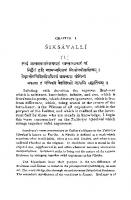

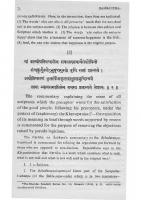
![The Upanishad Translated [1]](https://ebin.pub/img/200x200/the-upanishad-translated-1.jpg)
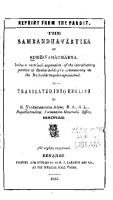
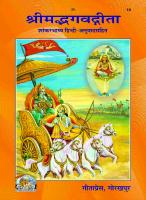


![Die Katha-Upanishad [Reprint 2020 ed.]
9783111413099, 9783111049120](https://ebin.pub/img/200x200/die-katha-upanishad-reprint-2020nbsped-9783111413099-9783111049120.jpg)
